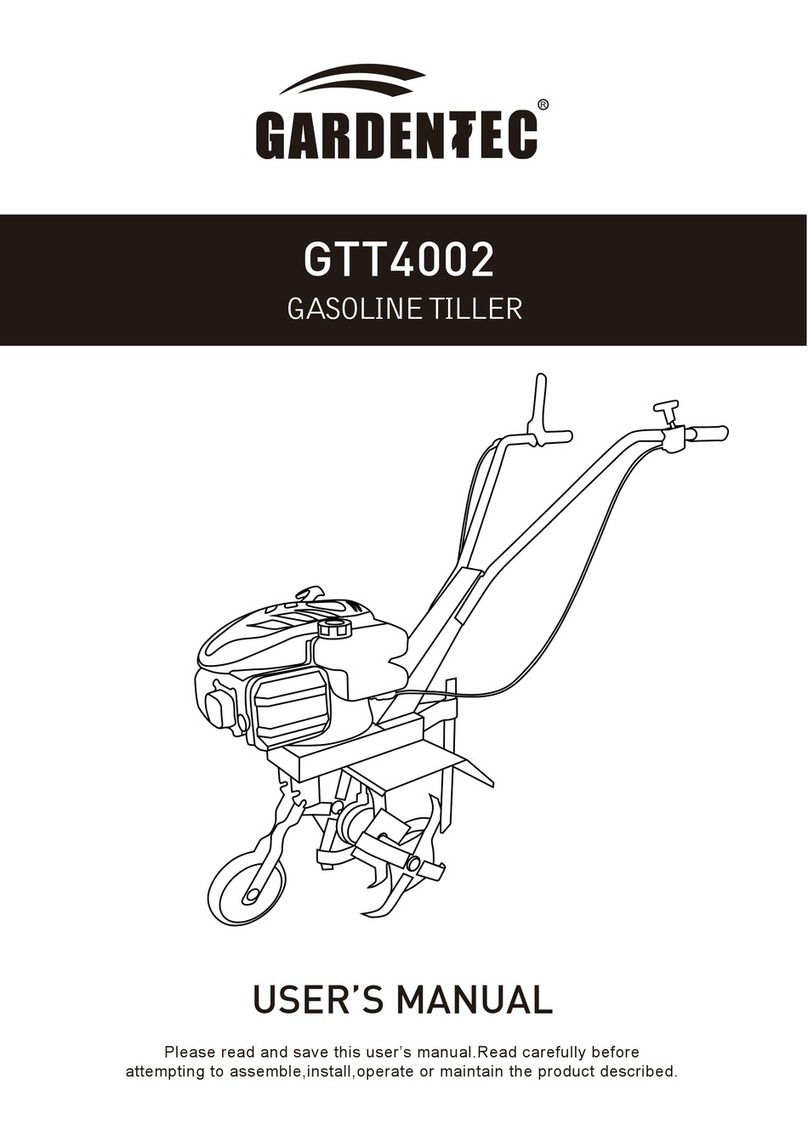
This entire book is filled with important safety information--please
read it carefully.
INTRODUCTION
SAFETY MESSAGES
Safety Labels
Safety Messages
Safety Headings
Safety Section
Instructions --how to use this tiller correctly and safely.
Your safety and the safety of others are very important.And using this
tiller safely is an important responsibility.
To help you make informed decisions about safety,we have provided
operating procedures and other information on labels and in this
manual.This information alerts you to potential hazards that could
hurt you or others.
Of course,it is not practical or possible to warn you about all the
hazards associated with operating or maintaining a tiller.You must
use your own good judgment.
You will find important safety information in a variety of forms,
including:
-- preceded by a safety alert symbol and one
of three signal words: DANGER,WARNING,or CAUTION.
These signal words mean:
You WILL be KILLED or SERIOUSLY HURT if
you follow instructions.don't
You CAN be KILLED or SERIOUSLY HURT if
you don't follow instructions.
You CAN be HURT if you don’t follow
instructions.
--such as
IMPORTANT SAFETY INFORMATION.
--such as
TILLER SAFETY.
STORAGE
STORAGE PREPARATION..........................................................................31
STORAGE PRECAUTIONS..........................................................................35
TAKING CARE OF UNEXPECTED PROBLEMS............................................................36
CONTENTS
TILLER SAFETY .................................................................................................1
CONTROLS ........................................................................................................4
IMPORTANT SAFETY INFORMATION .... .......2.................................................
SAFETY LABEL LOCATIONS..........................................................................3
COMPONENT &CONTROL LOCATIONS.......................................................4
CONTROLS ....................................................................................................5
SETTING UP YOUR NEW TILLER ...................................................................7
WHEEL ASSEMBLY.......................................................................................8
BUMPER ASSEMBLY....................................................................................8
HANDLE BAR BRACKET ASSEMBLY ..........................................................7
REVERSE CA ASSEMBLY......................................................................7BLE
CLUTCH CA ASSEMBLY.........................................................................7BLE
BEFORE OPERATION.......................................................................................9
OPERATION.....................................................................................................10
ARE YOU READY TO GET STARTED...........................................................9
IS YOUR TILLER READY TO GO...................................................................9
SAFE OPERATING PRECAUTIONS............................................................10
STARTING THE ENGINE..............................................................................10
OPERATING THE CONTROLS FOR TILLING.............................................13
HANDLING TIPS...........................................................................................14
STOPPING THE ENGINE.............................................................................15
CLUTCH CABLE ADJUSTMENT...................................................................24
REVERSE CABLE ADJUSTMENT................................................................24
SERVICING YOUR TILLER.............................................................................16
THE IMPORTANCE OF MAINTENANCE.....................................................16
MAINTENANCE SAFETY.............................................................................17
MAINTENANCE SCHEDULE........................................................................18
REFUELING..................................................................................................19
FUEL RECOMMENDATIONS.......................................................................20
ENGINE OIL LEVEL CHECK........................................................................20
ENGINE OIL CHANGE..................................................................................21
ENGINE OIL RECOMMENDATIONS............................................................22
TRANSMISSION OIL RECOMMENDATIONS...............................................22
AIR FILTER INSPECTION.............................................................................23
AIR FILTER CLEANING................................................................................23
DRIVE BELT CHANGE.................................................................................26
TINE REPLACEMENT..................................................................................29
SPARK ARRESTER SERVICE (optional equipment ) ..................................29
TIRE PRESSURE CHECK............................................................................30
SPARK PLUG SERVICE...............................................................................24




























